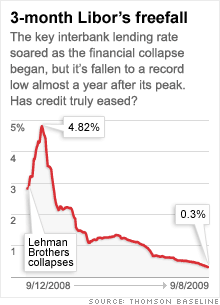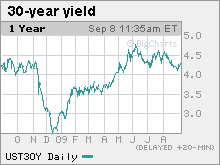Key lending rate sinks to record low
The 3-month Libor slips below 0.3% for the first time since records were kept, signaling stability but further declines could upset the equilibrium.

| Minimum payments only | |
| Fixed payments $ monthly |
|
| Debt-free deadline I want to pay off my credit cards in: years and months |
|
NEW YORK (CNNMoney.com) -- A key bank-to-bank lending rate fell to its lowest point on record Wednesday, signaling continued easing of the once-frozen credit markets.
Three-month Libor fell below 0.30% (0.269869%) for the first time since the British Bankers' Association started keeping records in 1986. That's a far cry from where rates sat just one year ago, when the 3-month rate peaked above 4.8% on Oct. 10.
After brokerage firm Lehman Brothers collapsed on Sept. 15, market volatility headed off the charts and banks quickly slammed their lending doors shut. The resulting credit crunch has been a hallmark of the recession.
The London Interbank Offered Rate -- or Libor -- is a daily average of rates that 16 different banks charge each other to lend money. A higher Libor rate indicates tighter credit, and lower rates can free up a choked market. More than $350 trillion in assets are tied to Libor, including many school, auto and home loans. The overnight Libor rate held steady Wednesday at 0.22%.
The Fed has been on a campaign to ease the credit crunch by slashing its interest rate, and by buying up long-term bonds to seed the financial system with money.
Three-month Libor is tied to the Federal Reserve's benchmark interest rate, making it a barometer of the central bank's monetary policy.
The Fed has held the interest rate at a range between 0% and 0.25% for the past six policymaking meetings.
"We're at an awakening point," said William Larkin, analyst at Cabot Money Management. "When you're this close to zero, people react."
A new normal. "What we're seeing is a new normal," Larkin said. "And we don't know what's to come -- how do we go from pouring money into the economy to pulling back and being more restrictive?"
The Fed may remain cautious even as recovery signs pile up, said Action Economics analyst Kim Rupert.
"We've been seeing evidence that a recovery is at hand, but they're nervous about removing support prematurely," Rupert said. "That will keep Libor headed south."
Larkin said the credit market will likely see stability in the short term, helping market participants to diversify their investments.
In this decade so far, the 3-month Libor has averaged 3.31% on a weekly basis, Larkin said. But without "current distortions" and lows after the 2001 terrorist attacks, the average is about 4%, he said.
Still, defining a "normal" range for the key rate is difficult, he said.
"In our current situation, low is good," Larkin said. "In a negative-growth economy, you want something stimulative."
Rupert disagreed. "These rates are a little bit nervewracking," she said. "We're not seeing any sign of resistance from policymakers, which shows economic conditions are still not strong enough to overcome their nervousness over the recovery."
Banks are the driving force. The borrowers who have gained access to capital are seen as the ones who deserve the credit, Larkin said, adding that banks will likely "step up the due diligence" when reviewing future loan applications. While many consumers may not feel the easing yet, credit has loosened, he said.
"The system is working," Larkin said. "The money is flowing into the higher parts of the marketplace. But [the government] has the gas all the way to the floor -- they can't really do anything else."
The Fed would prefer to deal with inflation rather than a double-dip recession, Larkin said, and that bias is probably already built into the credit system.
"They're looking at the 1930s and saying, 'We don't want a repeat of that,'" Larkin said. "That will be the question throughout 2010: How do we get such a fragile economy into a normal monetary policy? We can't stay at 0% forever."
Bonds slip. The credit crisis has also impacted government debt.
For example, in 2008, the 30-year note gained 41% in 2008, said Larkin. So far in 2009, it's lost 20% with its yield has skyrocketing 40% year-to-date, he added.
On Wednesday, the 30-year long bond fell 21/32 to 102-12/32 and yielded 4.36%. Bond prices and yields move in opposite directions.
The benchmark 10-year bond slipped 8/32 to 100-30/32, and its yield rose to 3.51% from 3.54% late Tuesday. The 2-year note ticked down less than 1/32 to 100-3/32 and its yield rose to 0.95%.
The 3-month yield, which is an indication of appetite for short-term bonds, rose to 0.14%. ![]()


